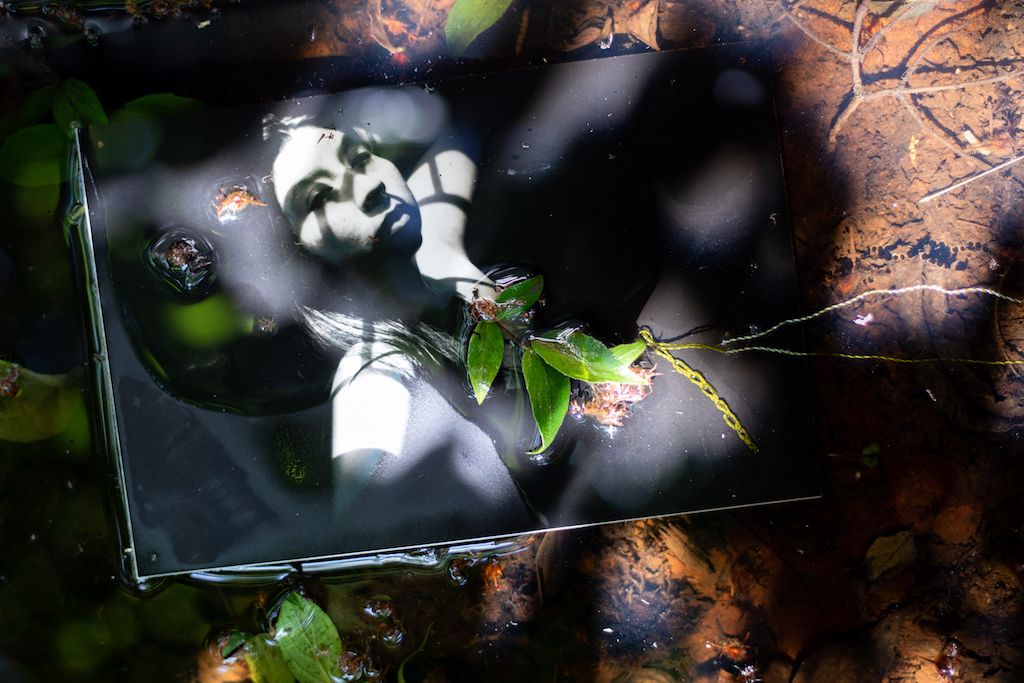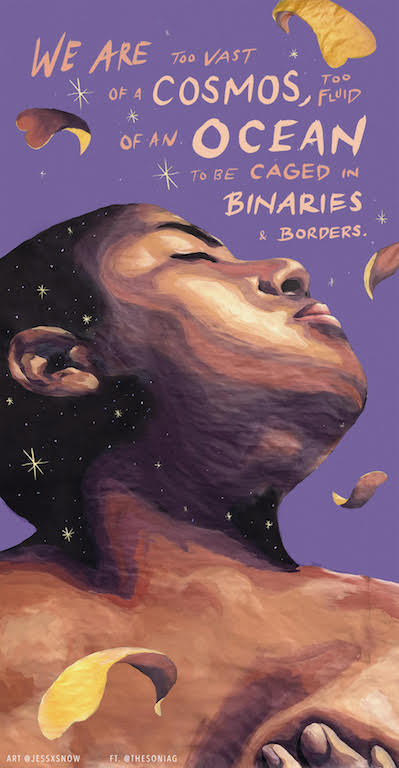
12.07.2021
Researcher Anamaría Garzón Mantilla reflects on the omission of the different states of migration in the history of Ecuador through the work of artists Eli Farinango and Sonia Guiñansaca, opening up sensitive encounters that go beyond the obtuse logic of borders.

“When you are an undocumented immigrant with undocumented
family, writing about undocumented immigrants
—and I can only speak for myself and my ghosts—
it feels unethical to put on
the drag of a journalist.
It is also painful to focus on the art, but impossible to
process the world as
anything but art.”
— Karla Cornejo Villavicencio, The Undocumented Americans
A year ago, borders were temporarily closed; flights were canceled, planes grounded, land crossings suspended. But for some people borders have always been closed, and that hasn’t stopped them from finding different ways to move around. Migration crises are not a recent phenomenon, nor is the inability of state agents to address them through solidarity.
Ecuador has expelled its people in constant flows since the 1960s. Dozens of studies have been published on the economic impact of remittances sent by migrants,[1] but there’s no discussion of the trauma caused by migration, the ways in which migrants themselves undertake their new lives, or the cultural practices linked to the migration process. When the eyes of the state shine with dollar signs, some people are only part of a cash-producing machine, and migration stories based on artistic practices and culture have no space in the public sphere. In the narrative of Ecuadorian art history, the situation is no different: migration is not a theme. The elephant in the room is invisible, possibly because of class shame, lack of interest, or the same absence of cultural institutions that have made Ecuador one of those invisible countries in the hegemonic narratives and exhibitions of the history of Latin American art.

Eli Farinango and Sonia Guiñansaca are the two artists this text will focus on. Both left Ecuador as children. Their parents migrated first and sent for them as soon as possible. Eli Farinango is a photographer and Sonia Guiñansaca is a poet. Their work includes self-representations, ways of looking within, and using images and words to get to know oneself, heal oneself, find oneself and others. In their stories, they carry trauma, but also an immense will to live, a power with which they disrupt the official accounts.
Eli Farinango and Sonia Guiñansaca go beyond the hegemonic narratives and set out to meet their ancestors; they expose their bodies and their voices in order to understand their present moment and prove that there is emancipation in self-representation, and also in joy and beauty.
“I find myself in a difficult transition. I left my job working in an institution for six years and it was a very nice place that I directed. Now, as an artist, I’m always doing that on the side. After I left, after that ended, I’ve been working as a full-time artist, full-time writer, full-time social worker. It’s good to wake up on my own schedule, have my coffee, and collect my thoughts in the morning, do whatever I need to do. So even sometimes when I’m not well, I have the freedom to not be well because I don’t have to perform. I can’t be okay all day long. And it feels good.”

Within the capitalist production system, we assume that a heavy workload and overtime are the standards and joy is a state whose arrival is postponed.
In a 1987 lecture, Gilles Deleuze said that the system wants us to be sad and that we have to be happy to resist it.[3] Happy, but also beautiful. Celebrating the power of non-normative bodies is also a form of resistance. In Nostalgia and Borders, the book that Sonia Guiñansca self-published in 2016 and which now has four editions, there’s a poem that holds its strength in the beauty of their mother and amplifies it in other glorious bodies like theirs, a queer body, a migrant body, a body that for many years was undocumented:
GLORY
Mi mamá se levanta
A las 7 de la mañana, se baña
Sus pies bendecidos en agua
Es divina
Después, empieza con su maquillaje
Her brown hands
Gently holding the black eyeliner
(for a migrant woman these are lines she welcomes)
She places her dark brown hair in a bun
Carefully placing bobby pins
Like carefully placing lipstick
Like carefully placing hope on land
Mami’s knowledge teaches me that my wings
Are meant to be thick
Meant to take up space
(these are rituals I grew up with)
So I repeat
Every morning creating self into existence
Between lipstick and softness
Between borders and belonging
(these are ways I survive)
So I repeat
Arching my eyebrows
Jewelry over my neck
Red nails pointy enough to hold homes
Homes I am building
(homes I left)
So I repeat
Adorning all my genders
(like the gospel never sung at my church)
This becomes biblical
Let this be an ode to femmes of color
Whose celestial eye shadows crack the heavens
Whose thick thighs resurrect possibilities
So I repeat
What glory we incite
What glory we create
What glory we are!
Other poems of Sonia’s reflect painful experiences—long-distance mourning, the silences in pleas made with calling cards, the recognition of the precariousness of migrants’ jobs—but Glory is a celebration and a license for joy:
“Much of my poetry breaks your heart, so I wanted to write a poem that comes from a place of joy and beauty. That’s not to say that my other poems don’t contain beauty, but there is tragedy and they just hurt. It still hurts. So, I was writing Glory as a way to celebrate my mom and all the women I know. My mom will get up very early and do her makeup, put everything on. I remember as I was getting ready for school, I noticed how my mom was doing her makeup and saw how she found time for herself. I was in the background, she was serving me breakfast, but that was her time. I think it changed the relationship I have with my mom. Because we understand people based on their relationship with us, so I thought: my mom is my mom. But as I grew older and understood my queerness, I realized that my mother was also simply Rosa. Rosa Magdalena Pañora likes her things in a particular way. She likes her little black eyeliner. She likes a little bun in her hair. She wears her perfumes … it was just a moment of recognizing that she is another person, she is a whole human being and she is a woman.
Just finding, discovering, and understanding my mom as her own person that had nothing to do with her relationship with me. I wanted to honor that at this time in my life when I am also my own person. I wanted to give a nice poem to my mother. My mom has seen most of my performances and it felt like I was breaking her heart all the time, so I just wanted to also have a nice poem where she feels good. That’s where Glory came in. I also made a video with it. I wanted to bring together queer women, non-binary, trans, and racialized people … At least for us—queer, trans, racialized, non-binary people—recovering ourselves is very important because we are not allowed to exist. There are laws that prohibit our lives, there are people murdered here in the U.S. and in different parts of the world. I just wanted to celebrate our lives, because there is so much death and lost hope. I wanted us to see each other alive somehow.”

In Healing Through Remembering, Eli shows how finding herself also means finding the mountains she loves, the women in her family, the knowledge of her ancestors, and the different languages in which she lives. When Eli went with her parents to Canada, she thought it would be a short trip and it was not. Nostalgia washed over her for several years. She is currently working on a series about the diaspora of the Kichwa community, starting with her family. The series is called Mindalae: Runa Kawsay. There is an overwhelming warmth to the photographs. It’s her family, and in her serene daily life, there are several feelings, several memories that intertwine with photomontages of other times. Eli has always taken pictures. It is her way of leaving herself messages, signs of life so that the Eli of the future remembers happy times; it is her way of taking notes, of meeting her family, and of taking control of her own story:
“For me photography is a way to be with myself, to understand the why of many things about myself; then it became a way to document. Photography has always been my companion; it has taken me out of dark moments and has given me the best joy. It helps me portray what is around me, the plants, my family … Despite being self-taught, I didn’t learn photography by myself; I learned with my sisters because I always took pictures of them or when I was taking my own portrait, they came to see what I was doing. Now I am very interested in the family archive, especially coming from a community; I think it is very important that we photograph ourselves. There are many families that have had cameras—I have an uncle who took pictures—but things are getting lost, the family archive is no longer valued. By recognizing how important it has been for me, I also want to show other people that our history is there. With Runa Kawsay I ask many questions. I have the privilege of taking charge of the narrative and becoming the owner of my own story; defiance is not letting them tell it for me. As an Indigenous woman, I sometimes see how other people are excising and extracting stories from our communities. That bothers me a lot; having access to my culture has been a very hard and long process. To be able to continue telling my story in order to heal things with my own family is a process, a life’s work, and I understand it as a very big responsibility. I do not want to replicate what has been done to us historically: we are studied without consent or the images that portray us do not show Indigenous people with dignity.
There are intimate family moments that I don’t want to portray and others where they know that my camera is present; that notion gives them the choice of how best to represent themselves, and self-representation is very important to me.”
In an economy that has been dollarized since 1999, remittances have been fundamental to sustaining the system, to the point that an article published in 2020 reported that in the last 20 years the country had received 49 billion 125.5 million dollars in remittances, an amount that represented 3.6 times the foreign direct investment. More information here.
Karla Cornejo Villavicencio, The Undocumented Americans (New York: One World, 2020).
Gilles Deleuze, Qu’est-ce que l’acte de création? Conference, FEMIS, March 17, 1987.
My mom gets up/ At 7 in the morning, she bathes/ Her feet blessed in water/ She is divine
[Then, she starts her makeup]
Comments
There are no coments available.